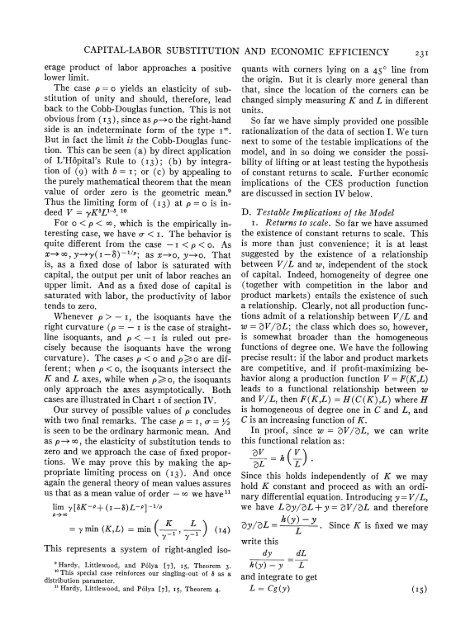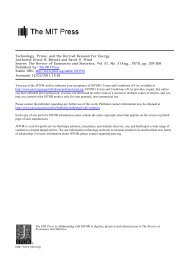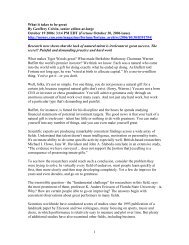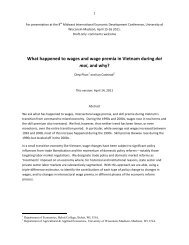Capital-Labor Substitution and Economic Efficiency Author(s): K. J. ...
Capital-Labor Substitution and Economic Efficiency Author(s): K. J. ...
Capital-Labor Substitution and Economic Efficiency Author(s): K. J. ...
Create successful ePaper yourself
Turn your PDF publications into a flip-book with our unique Google optimized e-Paper software.
CAPITAL-LABOR SUBSTITUTION AND ECONOMIC EFFICIENCY 21I<br />
erage product of labor approaches a positive<br />
lower limit.<br />
The case p = o yields an elasticity of substitution<br />
of unity <strong>and</strong> should, therefore, lead<br />
back to the Cobb-Douglas function. This is not<br />
obvious from (I3), since as p-*o the right-h<strong>and</strong><br />
side is an indeterminate form of the type i??.<br />
But in fact the limit is the Cobb-Douglas function.<br />
This can be seen (a) by direct application<br />
of L'Hopital's Rule to (I3);<br />
(b) by integra-<br />
tion of (g) with b = i; or (c) by appealing to<br />
the purely mathematical theorem that the mean<br />
value of order zero is the geometric mean.9<br />
Thus the limiting form of (I3)<br />
at p = o is in-<br />
deed V = yKIL1-. 1O<br />
For o < p < oo, which is the empirically in-<br />
teresting case, we have o- < i. The behavior is<br />
quite different from the case - i < p < o. As<br />
X?co, y>y7(i 8) -1/P; as x-*o, y-*o. That<br />
is, as a fixed dose of labor is saturated with<br />
capital, the output per unit of labor reaches an<br />
upper limit. And as a fixed dose of capital is<br />
saturated with labor, the productivity of labor<br />
tends to zero.<br />
Whenever p> - i, the isoquants have the<br />
right curvature (p =- i is the case of straight-<br />
line isoquants, <strong>and</strong> p < - i is ruled out pre-<br />
cisely because the isoquants have the wrong<br />
curvature). The cases p < o <strong>and</strong> p > o are dif-<br />
ferent; when p < o, the isoquants intersect the<br />
K <strong>and</strong> L axes, while when p> o, the isoquants<br />
only approach the axes asymptotically. Both<br />
cases are illustrated in Chart i of section IV.<br />
Our survey of possible values of p concludes<br />
with two final remarks. The case p = i, a- = '2<br />
is seen to be the ordinary harmonic mean. And<br />
as p-- oo, the elasticity of substitution tends to<br />
zero <strong>and</strong> we approach the case of fixed propor-<br />
tions. We may prove this by making the ap-<br />
propriate limiting process on (I3). And once<br />
again the general theory of mean values assures<br />
us that as a mean value of order - oo we have"<br />
lim y[8K-P+(I-8)L-P]-1/P<br />
p ->oo<br />
T r min (K,L) = min of n (I4)<br />
This represents a svstem of rig)ht-ang)led iso-;0<br />
'Hardy, Littlewood, <strong>and</strong> P6lya [7], I5, Theorem 3.<br />
"0This special case reinforces our singling-out of a as a<br />
distribution parameter.<br />
"Hardy, Littlewood, <strong>and</strong> P6lya [7], I5, Theorem 4.<br />
quants with corners lying on a 450 line from<br />
the origin. But it is clearly more general than<br />
that, since the location of the corners can be<br />
changed simply measuring K <strong>and</strong> L in different<br />
units.<br />
So far we have simply provided one possible<br />
rationalization of the data of section I. We turn<br />
next to some of the testable implications of the<br />
model, <strong>and</strong> in so doing we consider the possi-<br />
bility of lifting or at least testing the hypothesis<br />
of constant returns to scale. Further economic<br />
implications of the CES production function<br />
are discussed in section IV below.<br />
D. Testable Implications of the Model<br />
i. Returns to scale. So far we have assumed<br />
the existence of constant returns to scale. This<br />
is more than just convenience; it is at least<br />
suggested by the existence of a relationship<br />
between V/L <strong>and</strong> w, independent of the stock<br />
of capital. Indeed, homogeneity of degree one<br />
(together with competition in the labor <strong>and</strong><br />
product markets) entails the existence of such<br />
a relationship. Clearly, not all production func-<br />
tions admit of a relationship between V/L <strong>and</strong><br />
w = DV/IL; the class which does so, however,<br />
is somewhat broader than the homogeneous<br />
functions of degree one. We have the following<br />
precise result: if the labor <strong>and</strong> product markets<br />
are competitive, <strong>and</strong> if profit-maximizing be-<br />
havior along a production function V = F(K,L)<br />
leads to a functional relationship between w<br />
<strong>and</strong> V/L, then F(K,L) = H(C(K),L) where H<br />
is homogeneous of degree one in C <strong>and</strong> L, <strong>and</strong><br />
C is an increasing function of K.<br />
In proof, since w = DV/DL, we can write<br />
this functional relation as:<br />
DV V<br />
DL =*LJ<br />
Since this holds independently of K we may<br />
hold K constant <strong>and</strong> proceed as with an ordi-<br />
nary differential equation. Introducing y= V/L,<br />
we have L Dy/DL + y = D V/DL <strong>and</strong> therefore<br />
Dy/DL = k(y) - y . Since K is fixed we may<br />
L<br />
write this<br />
dy dL<br />
k(y)-y L<br />
<strong>and</strong> integrate to get<br />
L = Cg(y) ('5)







